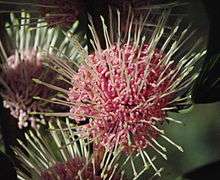Hakea petiolaris
| Hakea petiolaris | |
|---|---|
 | |
| Scientific classification | |
| Kingdom: | Plantae |
| (unranked): | Angiosperms |
| (unranked): | Eudicots |
| Order: | Proteales |
| Family: | Proteaceae |
| Genus: | Hakea |
| Species: | H. petiolaris |
| Binomial name | |
| Hakea petiolaris Meisn. | |
Hakea petiolaris, commonly known as the sea-urchin hakea, is a shrub or small tree which is endemic to the south west of Western Australia in a range between Wongan Hills and Hyden usually associated with granite outcrops and hills.[1]
Description
Hakea petiolaris grows as a tree or shrub up to 9 metres (30 ft) in height. The leaves have a distinctive pale-grey colour and are 5.5 to 15 cm long and 2.5 to 6 cm wide. Flowering occurs in autumn and winter (March to July), the inflorescences appearing on small branches or forks of branches. They are roughly spherical and contain 120 to 200 individual flowers. The pistils are 1.4 to 1.8 cm long and white or cream in colour. The perianth ranges from pink to purple. Flowering is followed by woody seed capsules which are 2 to 3.5 cm long and 1 to 2 cm wide. Each splits into valves and releases 2 dark brown or black winged seeds.
Response to fire is varied, with some forms resprouting from a lignotuber and others being killed and regenerating from seed.
Taxonomy
Hakea petiolaris was first described by Carl Meissner in 1845, after being collected near York by Ludwig Preiss.
It has three subspecies.
The main characteristics of the subspecies are in the flower colouring:[2]
- subsp. petiolaris - the perianth darkens to mauve and then pinkish red; it has the smallest leaves. It is the variety that is found in the Jarrah forest.
- subsp. trichophylla - the perianth darkens to mauve and then maroon: it is the most common subspecies in cultivation.[3]
- subsp. angusta - the perianth darkens to mauve and then pinkish mauve.[4]
Notes
- ↑ Nikulinsky, Philippa & Hopper, Stephen D (2008). Life on the rocks : the art of survival Fremantle Press, North Fremantle, W.A ISBN 9781921361289 (hbk.)(Previously published soft cover ed. 1999) page 64 - regarding granite outcrops and response to fire
- ↑ http://asgap.org.au/h-pet.html
- ↑ http://www.flora.sa.gov.au/efsa/lucid/Hakea/key/Australian%20Hakea%20species/Media/Html/Hakea_petiolaris_ssp._trichophylla.htm
- ↑ http://www.flora.sa.gov.au/efsa/lucid/Hakea/key/Australian%20Hakea%20species/Media/Html/Hakea_petiolaris_ssp._angusta.htm
External links
- "Hakea petiolaris". FloraBase. Western Australian Government Department of Parks and Wildlife.
- "Hakea petiolaris subsp. angusta". FloraBase. Western Australian Government Department of Parks and Wildlife.
- "Hakea petiolaris Meisn. subsp. petiolaris". FloraBase. Western Australian Government Department of Parks and Wildlife.
- "Hakea petiolaris subsp. trichophylla". FloraBase. Western Australian Government Department of Parks and Wildlife.
Further reading
- Young, Jennifer (2000) Hakeas of Western Australia : botanical districts of Irwin and Darling - the Northern Sandplains and the South-west Forest West Perth, W.A.. ISBN 0958577803
-
 Media related to Hakea petiolaris at Wikimedia Commons
Media related to Hakea petiolaris at Wikimedia Commons